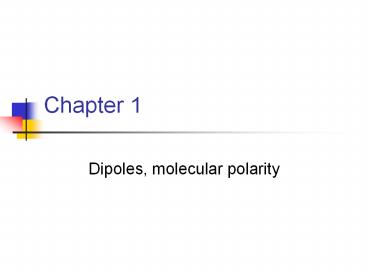Dipoles, molecular polarity - PowerPoint PPT Presentation
1 / 20
Title:
Dipoles, molecular polarity
Description:
Need # valence e- from all atoms. Need bond arrangement ... Lone pair at N molecular geometry/shape is trigonal pyramidal. Which molecule is more polar? ... – PowerPoint PPT presentation
Number of Views:505
Avg rating:3.0/5.0
Title: Dipoles, molecular polarity
1
Chapter 1
- Dipoles, molecular polarity
2
Ways to Represent Polarity in Molecules
electron rich region
electron poor region
3
Dipole Moment (m)
electron rich region
electron poor region
m q x r
moment in Debyes (D) 1 D 3.36 x 10-30
Coulomb.meter
bond length
magnitude of charge d d-
4
Explain the Trend
5
More Complex Molecules?
- Consider
- molecular shape (bond orientation)
- bond polarity
- lone pairs
- (and sometimes) atom size
- What is symmetry of e- distribution?
6
Consider NH3
- Lewis Structure
- Need valence e- from all atoms
- Need bond arrangement (connectivity)
7
Consider NH3
- Lewis Structure
- valence e- 5 (N) 1 (3H) 8e-
- Three N-H bonds
8
Consider NH3
- From the Lewis structure
- Deduce e- pair geometry at central atom
- THEN find molecular geometry/shape
- Any predictions?
9
Consider NH3
molecular shape individual bond dipoles lone pair
dipoles
- 4e- pairs at N
- tetrahedral e- pr geometry
- Lone pair at N molecular geometry/shape is
trigonal pyramidal
10
Which molecule is more polar?
molecular shape individual bond dipoles lone pair
dipoles
11
Which molecule is more polar?
12
Which molecule is more polar?
13
Attractions Between Dipoles
d d-
14
- Ecoulomb a q
- Ecoulomb a 1/d
15
Dipole-Dipole Interactions
d d-
d d-
d d-
d
d
...
...
- Dipoles align, d of one dipole to d- of another
- Magnitude of attraction
- Ecoulomb a (d)(d-)/d
- Increases with dipole moment
- 5-25 kJ/mol
16
Hydrogen Bonding Special Type of Dipole-Dipole
Attraction
..
N O F
N O F
H
From another molecule
From one molecule
H bond
d- d
d- d
..
- Only applies to molecules with H bonded to N, O,
or F - 10-40 kJ/mol (larger than most dipole-dipole
attractions)
17
Why Are Hydrogen Bonds So Strong?
Ecoulomb a (d)(d-)/d
H bond
- DEN for H and N,O, F very large, so
- N-H, O-H, F-H bonds are very polar (d, d- are
large) - H atoms are small, so
- N, O, F of one molecule can closely approach H of
another molecule (d is small)
18
Hydrogen Bonds in Water
19
Large Molecules Can Have Intramolecular Hydrogen
Bonds
20
Hydrogen Bonds in Chitin































